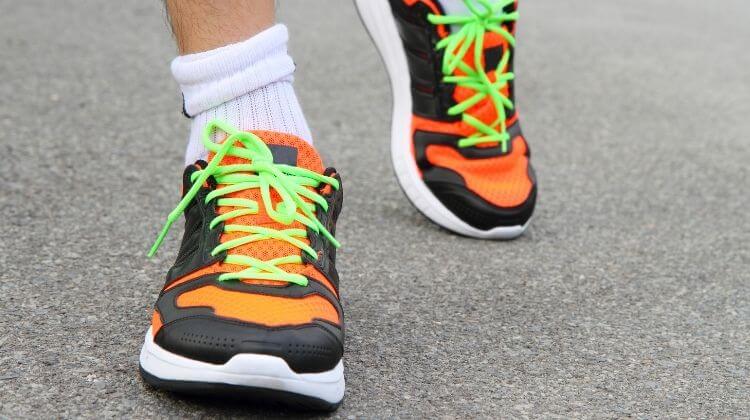
How long does it take to walk a mile? Everyone’s age and health is different, so results will vary greatly, but if you have to ask me how long it takes, I’ll tell you about 15-20 minutes.
To everyone’s knowledge, running is often the first type of cardiovascular exercise that comes to mind when thinking about the best possible training to help them achieve a healthier body. It’s raw, the mechanics aren’t complicated, and you can do it anywhere with zero equipment. You just need a good pair of sneakers and awesome music on full blast to keep you set!
However, it requires a higher pace and intensity that would often leave most people breathless in the first 5 minutes. The sheer thought of that is enough to put some people off and become less motivated even to do it.
So what’s the alternative?
Believe it or not, walking can be just as good as any workout exercise like running or any full-blown workout at the gym. It’s an excellent workout option for those who are only at the beginning of a fitness journey or find difficulty in high-intensity exercises. And walking a mile-long radius each day can be the best first step that you can incorporate into your workout routine.
But how long does it take to walk a mile long-distance anyway? How many minutes is one mile? What are the exact benefits of doing it every day? Let’s talk more.

The LISS or Low-Intensity Steady State Cardio Method
Walking is a type of Low-Impact Exercise. It can be associated as a LISS or Low-Intensity Steady State cardio method that generally requires low to moderate intensity executed in a more extended period with zero recovery periods. Here is a direct opposite of High-Intensity Interval Training (HIIT), which prompts a combination of heavy-hitting cardio exercises with brief or long recovery periods.
A Low-Impact exercise is more recommendable to the following people:
- Beginners
- Obese and Overweight Individuals
- Older Adults
- People who are suffering from ailments, such as osteoporosis and arthritis.
- People who have joint, bone, or tissue injuries.
- Pregnant Women
It is mostly the case since this type of exercise doesn’t stress the joints and body than HIIT exercises. Walking is a suitable exercise that is achievable for nearly everyone at any age or fitness level. It poses a lesser risk for injury and strain on the body that can be very beneficial for weight loss, endurance training, and overall health.

How Walking a Mile Daily Can be Beneficial for Your Health?
Promotes Weight Loss and Muscle Tone – Weight Loss is achievable through walking. With just 10,000 steps a day can be as effective and enough like a full-blown workout; more so if you have some variations with your pace or walk or going at a steady pace on an incline. In most cases, a great catch to walking at a low to mid-impact pace is that you won’t have to suffer through unbearable muscle pain that would keep you from doing the exercise again the next day. It also improves digestion by regulating your bowel movement, which is an excellent thing for weight loss and people suffering from constipation.
Improves Mental Health – Low-impact exercises such as walking can significantly impact your mental health. It helps stimulate the neural blood vessels and cells that are responsible for producing endorphins. Also, researchers from the University of Kansas found that walking can help reduce the risk of developing Alzheimer’s disease and Dementia.
Sturdier Bones and Joints – Walking can be an excellent form of exercise that can significantly improve your joints’ mobility and prevent osteoporosis by reducing the loss of bone density. Those, in turn, also reduces the risk of your bones getting fractures. According to the Arthritis Foundation, merely walking 30 minutes a day can be enough to reduce stiffness, pain, and joint inflammation in the body.
Improves Brain Health – One study in particular from the University of Kansas shows that low-impact aerobic exercises such as walking can effectively help reduce the risk of developing Alzheimer’s disease and prevent the early onset of Dementia. People who are more active throughout their lives are less susceptible to these diseases than people who opt to live a sedentary lifestyle. It also aids in the growth and survival of neural blood vessels and cells.
Promotes Better Posture – If you’re also looking into improving your body’s posture, then walking is the next best thing to do. It contributes to better circulation of the blood within the body’s spinal structures. It will help pump out essential nutrients into the soft tissues, enough to keep the spine healthy and improve your overall flexibility and posture. Through walking, you can strengthen the muscles that support your body upright and make your spine more stable.
Helps Reduce Stress by Releasing Endorphins – Walking can effectively stimulate the production of chemicals in our brain, such as Endorphins, which is generally good for our mental health. Having a clearer mind is a bonus when dealing with hectic and stressful lives. Remember, your mental health is as essential as your body’s health as well.
Helps Prevent Heart Disease and Diabetes – Another significant benefit of walking is that it helps lower blood pressure, which prevents the potential risks of heart disease. It is also an efficient way to prevent diabetes as walking contributes to effectively lowering your blood sugar.
Improves Lung Health and Blood Circulation in the Body – Cardiovascular exercises such as walking increase the oxygen flow in the bloodstream and aids in eliminating toxins, which makes it a great way to maintain a healthy set of lungs. Merely having a 30-minute walk a day is enough to increase your lung capacity, which would also help you breathe easier and make your lungs more healthy and more resilient to diseases.
Improves Eyesight – Believe it or not, walking helps improve your eyesight. A study from the Glaucoma Research Foundation stated that doing a low-impact exercise such as walking is one of the best ways to reduce Glaucoma’s risk. Glaucoma develops when there is too much fluid build-up in the eye, leading to visual impairment. Doing cardiovascular exercises such as walking would help stimulate the brain’s visual cortex, a part of the mind that allows process whatever image our eyes see.

How Long Does it Take to Walk a Mile on Average Person?
Suppose you are set to commit yourself to walk a mile per day as an exercise. In that case, you may be wondering how “fast” or “slow” should you be going to reap maximum benefits from your workout? A regular person can cover a mile-long distance in about 15 to 20 minutes to an average extent. Still, how fast a person should go depends on several factors such as your age, sex, and fitness level.
A critical determinant factor to keep in mind is to walk at a comfortable pace for your body. If you are still new to this and quite uncertain of your exact walking pace, you can start by measuring your heart rate. Fitness trackers and heart rate monitors are very trendy nowadays. You can easily download fitness apps on your phone that can help keep track of your heart rate.

How Fast Should I Walk a Mile for My Age?
Beginner: This pace takes about 50 – 60 percent of your maximum heart rate. Here, you are walking at a pace that is enough to carry a conversation and talk comfortably with a bit of breathlessness.
Intermediate: This pace carries around 64 – 76 percent of your maximum heart rate. At this rate, you may experience heavy breathing but still can talk in short sentences. It is especially important to attain when you are aiming to lose weight.
Advanced: This is a pace that takes up about 77 to 93 percent of your maximum heart rate and can be a viable option if you are looking for muscle tone and a more athletic composition in your body. You may be breathing more heavily than before and can speak in phrases.
The 1 Mile Walking Test
Another great idea for analyzing your body’s overall fitness level is doing the 1 Mile Walking Test. The American Council of Exercise in the Cooper Institute provided a detailed age-based structure that can give you a better idea to measure the proper amount of time you should take to walk a distance of 1 mile. It could be an excellent basis to track your progress that depends on how fast you can cover a mile radius in a steady brisk pace:
MALE
| AGE | 20-29 | 30-39 | 40-49 | 50-59 | 60-69 | 70+ |
| Poor | >14:30 | >15:00 | >15:30 | >16:30 | >17:18 | >20:18 |
| Fair | 13:43-14:30 | 14:13-15:00 | 14:43-15:30 | 15:13-16:30 | 16:19-17:18 | 18:49-20:18 |
| Average | 13:01-13:42 | 13:31-14:12 | 14:01-14:42 | 14:25-15:12 | 15:13-16:18 | 15:49-18:48 |
| Good | 11:54-13:00 | 12:24-13:30 | 12:54-14:00 | 13:24-14:24 | 14:06-15:12 | 15:06-15:48 |
| Excellent | <11:54 | <12:24 | <12:54 | <13:24 | <14:06 | <15:06 |
FEMALE
| AGE | 20-29 | 30-39 | 40-49 | 50-59 | 60-69 | 70+ |
| Poor | >16:30 | >17:00 | >17:30 | >18:06 | >19:12 | >24:06 |
| Fair | 15:07-16:30 | 15:37-17:00 | 16:07-17:30 | 17:01-18:06 | 17:31-19:12 | 21:49-24:06 |
| Average | 14:07-15:06 | 14:37-15:36 | 15:07-16:06 | 15:37-17:00 | 16:19-17:30 | 20:01-21:48 |
| Good | 13:12-14:06 | 13:42-14:36 | 14:12-15:06 | 14:42-15:36 | 15:06-16:18 | 18:18-20:00 |
| Excellent | <13:12 | <13:42 | <14:12 | <14:42 | <15:06 | <18:18 |
However, it is essential to note that the given data above is just a basis. It doesn’t account for your overall success. As mentioned, the results may vary depending on the person. If you don’t meet the time in the charts, then keep going. As long as you can start somewhere, if you continue to walk a mile or two every day, it is a guarantee that you’ll see improvements!

Tips to Reap Maximum Benefits in Long Distance Walking
- Wear Comfortable Shoes – If you’re going to walk a mile or more, then you should opt to use comfortable footwear—something fit, light on the feet, and sturdy enough to keep up with some long-distance walking. Getting blisters is the last thing you’ll ever want to have when you are set to do this daily.
- Do Some Stretches before you Walk – As with any other exercise, doing pre-workout stretches is the best thing to do first to prepare your body well enough, even if you will go for a low to mid-impact pace in your walk. You’re still going at a long distance, so it’s best to do so to avoid cramps.
- Remember to Use Proper Form – Keeping a proper form as you walk is essential as well. You’ll only make things more difficult in the long run if you slouch. Remember to keep your spine straight and have your elbows bent at a 90-degree angle. It would help if you also swung your arms to stabilize your Pelvis.
- Watch Your Pace – It’s best to set a steady and optimal pace that fits and stick to it throughout your walk. As exciting as it might go, remember to keep yourself from breaking into a jog.
- Get a Proper Diet –. If you’re aiming to lose 10 pounds or any fitness goal, this is already a given. Walking a mile or more a day can still tire your body out, so it’s best to watch your diet and eat the right food that can power you through in your long walks. Get the right balance in your macros with a decent amount of Protein, Carbs, fat and fiber, and vitamin-rich vegetables and fruits. You’ll be going at a reasonable distance, so it’s best to give your body the fuel it needs to endure the space effectively.
- Keep Hydrated at all times – Don’t forget to drink the right amount of water before your walk, just the right amount to keep your body hydrated. It is also recommendable to bring a glass of lemon water with you, mostly if you cover a long distance.
- Get a Fitness Buddy – What better way to enjoy an exercise than having a friend or loved one with you through it? It can help set you in a better mood and motivate you enough to achieve your goal!
Setting up your Routine: The FIT Formula
When you are still troubled about doing too much right away, you can use the FIT (Frequency, Intensity, and Time) formula as a basis before you execute your walk. You should ask the right questions for yourself: How often can you do your walks? How fast can you go? How long can you take it? All of this determines how you’ll progress in your exercise. What matters is that you set up a routine that you are comfortable enough to do consistently.

Can Children Walk a Mile per Day?
Walking as an exercise is for everyone! Introducing it as a form of exercise to your kids can be an excellent passage for bonding time. Research from the Daily Mile foundation indicates that children who walking or running a mile a day is much healthier than sedentary peers. It would take an average child around 30 minutes at a brisk pace. Still, it all differs depending on their level of comfortability.
How Many Calories Do You Lose When Walking a Mile?
The number of calories you burn per mile walk depends on how much you weigh. For example, a person of 120 pounds can lose about 65 calories while covering a mile at a brisk pace. Suppose you want a more accurate finding of how many calories you can burn. In that case, there are plenty of fitness apps that can track the exact number of calories you can burn during your mile walk.

Can You Lose Weight by Walking a Mile?
Walking as an exercise is just as effective as running or any other full-blown workout at the gym. Doing it is one successful way to shed the extra weight from your body and, at the same time, tone and make your muscles stronger. A great catch with low to mid-impact exercises like walking is that it prevents any severe strain or pain on your strengths that would hinder you from repeating the training on the next day.
However, as with any weight loss regime, it is vital to consider getting the proper diet and nutrition like 7-Day meal plan, your body needs to sustain your health through your long walks. It’s best to start cutting down on unhealthy food and incorporate well-balanced macros of Protein, Carbs, and Fat into your diet. Walking helps regulate a person’s bowel movement, which, in turn, improves the body’s digestion process.
Does the Walking Speed Affect Walking Time?
Speed and time go hand in hand. The faster your pace is, the shorter the time it would take to cover a mile. Now, the rate you should follow, however, depends entirely on you. Which begs the question: Exactly how fast should you walk a mile?
The Bottom Line
Now, is walking a mile a day necessary? No. As we’ve covered, you are free to go at your own pace or whichever distance, time frame, or speed your body can handle. But setting goals like any other workout is essential, and aim to walk a mile a day is a great start.
Another great thing about walking is that you sometimes don’t even have to be incomplete fitness gear to do it, and you can easily slip it into your daily schedule. It is especially true in urban areas. If you live in the city with your favorite restaurant or grocery a mile or two away, you can save the cost of gas or fare by merely taking a walk. Even walking your dog to the park is good enough to add a couple of steps towards your goal.
Walking is a great exercise everyone can do and should be doing more frequently. Nowadays, we often get so hung up on our phones that we often miss the opportunity to get up and step out to the great outdoor’s fresh breeze. Doing a walk not only improves your body’s health and mind, but it also gives you time to reflect, get a fresher perspective, and a better appreciation of life.










